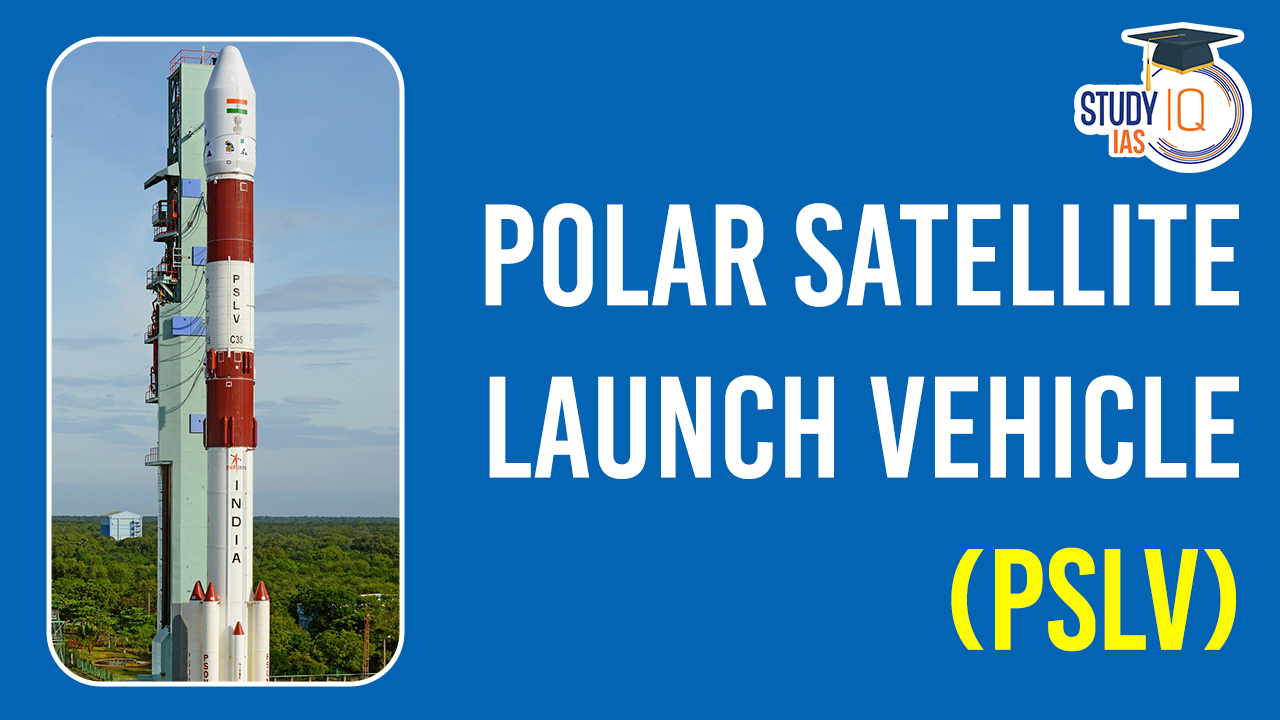Table of Contents
The Polar Satellite Launch Vehicle (PSLV) is an expendable launch vehicle developed and operated by the Indian Space Research Organization (ISRO). It is primarily used to launch satellites into polar orbits, geosynchronous transfer orbits (GTO), and sun-synchronous orbits. The PSLV is one of the most successful and reliable launch vehicles in ISRO’s fleet.
What is PSLV?
The Polar Satellite Launch Vehicle (PSLV) is a prominent Indian Space Research Organization (ISRO) development, belonging to the medium-lift launcher category. It has the capability to access various orbits, such as the Geo Synchronous Transfer Orbit, Lower Earth Orbit, and Polar Sun Synchronous Orbit. PSLV operations are centered at the Satish Dhawan Space Center on India’s east coast.
Configuration and Stages
- First Stage: PSLV features a four-stage system that combines solid and liquid-fueled rocket stages. The first stage, located at the base, is solid-fueled and is augmented by six strap-on solid rocket boosters.
- Second Stage: The second stage is powered by liquid fuel, providing additional thrust during launch.
- Third Stage: The third stage is solid-fueled, contributing to the launcher’s propulsion system.
- Fourth Stage: The fourth stage uses liquid propellant to achieve orbital insertion.
Payload Capacity
The launch vehicle’s weight can range between 229,000, 296,000, or 320,000 kilograms, depending on mission requirements. PSLV can be tailored to three distinct configurations:
- Standard Version: The flagship version can carry up to 1,050 kilograms into Geo Synchronous Transfer Orbit and 1,600 kilograms into Polar Sun Synchronous Orbit.
- Core Alone: Launched without the six strap-on boosters and with less upper-stage propellant, this configuration is primarily designed for missions with smaller payloads.
- XL Version: The XL variant includes additional propellant in the strap-on solid rocket boosters, enabling a higher payload capacity.
Notable Launches
As of September 2015, PSLV has an impressive track record, with 87 successful satellite launches into various orbits. Notable launches include:
- Chandrayaan-1: India’s first moon probe.
- Mangalyaan-1: India’s inaugural Mars orbiter mission.
- Astrosat: India’s first dedicated multi-wavelength space observatory.
PSLV Variant
| PSLV Variant | No. of Strap-On Motors | Payload Capability to SSPO (600 km) | Payload Capability to Sub GTO (284 x 20,650 km) |
| PSLV-CA | Nil | 1019 Kg | Not Applicable |
| PSLV-DL | Two | 1257 Kg | Not Applicable |
| PSLV-QL | Four | Not Applicable | Not Applicable |
| PSLV-XL | Six | 1523 Kg | 1425 Kg |
Polar Satellite Launch Vehicle (PSLV) Orbital Experimental Module
The Polar Satellite Launch Vehicle (PSLV) Orbital Experimental Module (POEM) serves as a platform for conducting in-orbit experiments using the usually discarded final stage of the ISRO’s PSLV rocket.
In the recent PSLV-C53 mission, the PS4 stage was repurposed as a “stabilized platform” for these experiments. POEM carries six payloads, including contributions from Indian space startups Digantara and Dhruva Space.
To keep POEM operational and stable in orbit, ISRO has implemented several key features:
- Power Generation: POEM will draw power from solar panels mounted around the PS4 tank, harnessing energy from the sun. Additionally, it is equipped with a Li-Ion battery to store and provide power as needed.
- Navigation: The platform will use multiple systems for navigation, including “four sun sensors” to track the sun’s position, a magnetometer for measuring the Earth’s magnetic field, gyros for orientation, and NavIC (Navigation with Indian Constellation) for satellite-based positioning and timing information.
- Control Thrusters: POEM features dedicated control thrusters that use stored helium gas to control and adjust its position and orientation in orbit, ensuring stability.
- Telecommand: It is equipped with a telecommand feature, which allows ground control to send instructions and commands to the module, enabling active management and operation of the platform.
PSLV vs SSLV
| PSLV | SSLV | |
| Full Name | Polar Satellite Launch Vehicle | Small Satellite Launch Vehicle |
| Development Stage | Established and operational since 1993 | In development, as of my last knowledge cutoff in September 2021 |
| Launch Capacity | Medium-lift launcher | Light-lift launcher |
| Payload Capacity | Varies depending on configuration, but typically capable of launching payloads ranging from 1,000 to 1,900 kilograms into various orbits | Targeted at launching small satellites, with payloads ranging from 500 to 700 kilograms into sun-synchronous orbits |
| Variants | Multiple variants available (CA, DL, QL, XL) | Designed as a dedicated small satellite launch vehicle |
| Stages | Four-stage system (solid and liquid-fueled) | Intended to have a two-stage configuration |
| Primary Use | Used for launching a wide range of satellites, including Earth observation, communication, navigation, and scientific satellites | Designed specifically for launching small satellites, including CubeSats and small payloads, with a focus on dedicated and cost-effective launches |
| Mission Flexibility | Known for its adaptability and versatility, capable of various mission profiles and orbital destinations | Intended to streamline small satellite launches, offering more cost-effective and dedicated solutions for the emerging small satellite market |
| Track Record | Successful track record with numerous missions, both for Indian and international customers | In development, awaiting its maiden flight, with expectations of providing dedicated launches for small satellite constellations |
| Operational Status | Currently operational and widely used by ISRO | In development, planned for future operational use |
| Mission Frequency | Regularly used for a variety of missions | Intended to support a higher launch frequency for small satellite missions |
| Launch Center | Launched from the Satish Dhawan Space Centre (SDSC) in Sriharikota, India | Intended to be launched from the same location, SDSC SHAR, as well as other potential sites |
Recent PSLV Launches
| Year | Launcher Type/Title | Payload | Description |
| 2021 | PSLV-C51 | Amazonia-1 | Launched Amazonia-1, an optical earth observation satellite of the National Institute for Space Research (INPE) along with 18 co-passengers on February 28, 2021, from Satish Dhawan Space Centre SHAR, Sriharikota. |
| 2020 | PSLV-XL/PSLV-C50 | CMS-01 | Launched India’s Communication Satellite on 17th December 2020 from Satish Dhawan Space Centre (Harikota, Andhra Pradesh) into Geosynchronous Orbit (GSO). |
| 2020 | PSLV-DL/PSLV-C49 | EOS-01 | Launched an Earth observation satellite along with nine international customer satellites from SDSC SHAR on 7th November 2020 into Low Earth Orbit (LEO). |
| 2019 | PSLV-QL/PSLV-C48 | RISAT-2BR 1 | Launched an Earth observation satellite along with nine commercial satellites from Israel, Italy, Japan, and the US on 11th December 2019. It marked the 75th launch vehicle mission. |
| 2019 | PSLV-XL/PSLV-C47 | Cartosat-3 | Launched the third-generation agile advanced satellite along with 13 commercial nanosatellites from the US on 27th November 2019 into Sun-Synchronous Polar Orbit (SSPO). |
| 2019 | PSLV-CA/PSLV-C46 | RISAT-2B | Launched RISAT-2B without solid strap-on motors on 22nd May 2019. |
| 2019 | PSLV-C45 | EMISAT | Injected EMISAT into orbit on 1st April 2019, along with 28 international customer satellites. |
| 2019 | PSLV-C44 | Microsat-R and Kalamsat-V2 | Launched Microsat-R and Kalamsat-V2 satellites into their designated orbits on 24th January 2019 from SDSC SHAR. |
Polar Satellite Launch Vehicle (PSLV) UPSC
The Polar Satellite Launch Vehicle (PSLV) is a versatile and reliable launch vehicle developed and operated by the Indian Space Research Organization (ISRO). It is used to launch satellites into a range of orbits, including polar orbits, geosynchronous transfer orbits (GTO), and sun-synchronous orbits. PSLV features a four-stage system with solid and liquid-fueled stages, and its payload capacity can be adjusted to mission requirements, with variants like PSLV-CA, PSLV-DL, PSLV-QL, and PSLV-XL. Notable PSLV launches include Chandrayaan-1, India’s first moon probe, Mangalyaan-1, its inaugural Mars orbiter mission, and Astrosat, the first Indian multi-wavelength space observatory. ISRO also introduced the Small Satellite Launch Vehicle (SSLV) for dedicated small satellite missions.


 Vitamin D Deficiency: Causes, Symptoms a...
Vitamin D Deficiency: Causes, Symptoms a...
 GAURAV: Long Range Glide Bomb (LRGB)
GAURAV: Long Range Glide Bomb (LRGB)
 Gestational Diabetes Mellitus (GDM), Cau...
Gestational Diabetes Mellitus (GDM), Cau...





















